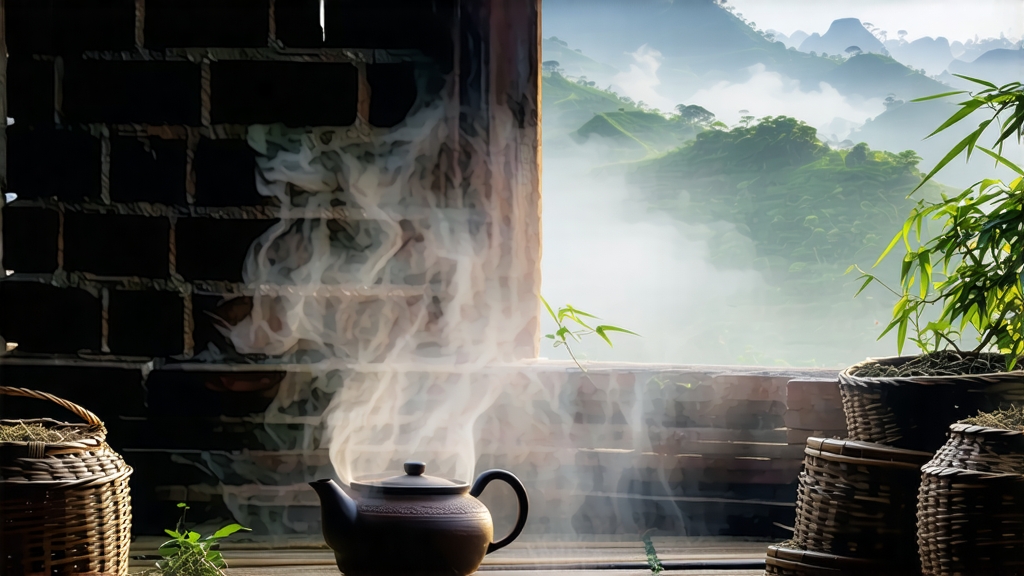
Tucked away in the humid, karst-pocked southwest of China, the small district of Liu Bao in Guangxi has been quietly producing one of the world’s most cellar-worthy teas for over four centuries. To most Western drinkers “dark tea” still means Pu-erh, yet Liu Bao—older than many Yunnan recipes—offers a softer, more camphor-sweet gateway into the realm of post-fermented teas. Its story begins with Ming-dynasty border troops who needed a beverage that would neither sour nor mildew on long southern campaigns. Local growers found that a double turn of heat, humidity and time could transform coarse mountain leaves into a deep ruby liquor that settled stomachs and lifted spirits. From that martial necessity grew a tea that would travel the 18th-century Tea Horse Road, be pressed into bamboo-sheathed bricks for sampans heading to Hong Kong, and eventually age in the dim basements of Malay tin miners who still call it “kopi tiam hitam”—the black coffee of the Chinese diaspora.
Liu Bao belongs to the hei cha (dark tea) family, a category defined not by leaf colour but by microbial fermentation after the kill-green stage. Within Guangxi alone, three sub-styles survive: the traditional basket-aged “Lao Liu Bao,” the modern wet-piled “San He” blend, and the small-batch “Shan Cha” picked from wild Camellia sinensis var. sinensis bushes above 800 m. Each style shares the same starting material—large-leaf, late-flush tea that would be too astringent if sold as green—yet diverges in the post-processing that Liu Bao masters call “dui wo,” the art of guided rotting.
The craft begins under the midsummer moon when pickers climb terraced slopes shrouded in subtropical cloud. Standard is one bud with the fourth or fifth leaf, mature enough to hold polyphenols yet still pliable. After a brief outdoor withering to reduce grassy notes, leaves are sent to the village “lang”—a long, wood-fired trough whose walls radiate gentle heat. Here they are tossed by hand for exactly 12 minutes until the edges bruise and the unmistakable scent of steamed edamame rises. Next comes the wok kill-green, but unlike green tea’s snap-bright finish, Liu Bao’s goal is to leave residual enzymes that will awaken later in storage. Masters judge the moment by ear: when the crackle of evaporating moisture deepens to a low hiss, the leaves are yanked out and immediately rolled under hemp cloth until ropey and jet-black.
What follows is the step that separates Liu Bao from every other dark tea: the wet pile. Leaves are heaped 70 cm high on bamboo mats, misted with mountain spring water, and covered with thick jute sacks. Inside this compost-like core, thermophilic bacteria bloom, pushing the pile’s heart to 58 °C within 36 hours. Every night for the next fortnight a “dui shi” specialist turns the heap, using bare forearms to gauge moisture—too dry and the tea will taste woody, too wet and it risks deadly aflatoxin. When the leaf veins turn chestnut and a damp, earthy perfume reminiscent of petrichor rises, the pile is broken and spread under the eaves to cool. At this point the tea is drinkable, but only as a rough, metallic brew that the locals call “mao cha” and sell to factories for blending.
True Liu Bao demands the slower second act: bamboo-basket aging. The semi-fermented leaf is steamed again, pressed by foot into cylindrical wicker baskets lined with wild taro leaves, and stacked in riverside warehouses whose walls weep with humidity. For the next three to thirty years the tea breathes through the lattice, inhaling the resinous scent of camphor logs burned to keep insects at bay. Each season the baskets are rotated, and every five years a master cracks one open, yanking out a fistful to check the “song” or looseness—too tight and the core will sour, too loose and the fragrance dissipates. Over decades the leaf darkens to obsidian, the liquor gains the viscosity of Amontillado sherry, and the flavour drifts from wet earth to dried longan, then to the prized “chen xiang” note that Chinese connoisseurs liken to vintage agarwood.
To brew Liu Bao well, one must unlearn the gentle rituals of green tea. Start by breaking—not cutting—a 5 g wedge